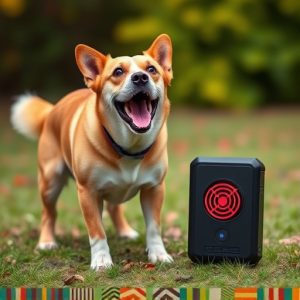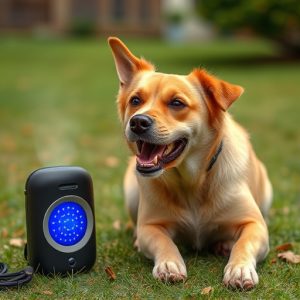Electronic Pet Deterrents: Settings, Safety, and Effective Training
Electronic pet training collars use stimuli like shocks or sounds to discourage unwanted behaviors,…….
Electronic pet training collars use stimuli like shocks or sounds to discourage unwanted behaviors, with safety regulations covering shock intensity and frequency to protect pets. Setting-based deterrents emit harmless signals to keep pets away from restricted areas indoors and outdoors, making them effective training tools without causing harm. Responsible use requires careful consideration of local Electronic Pet Deterrent Safety Regulations and tailoring device settings to pet needs. Training should start at low sensitivity, with positive reinforcement, and gradually increase as the pet learns.
“Discover the innovative world of electronic pet deterrents, a game-changer in responsible pet ownership. This comprehensive guide explores how these devices work and their numerous benefits for managing pet behavior. From understanding the technology behind them to navigating safety regulations, we cover it all.
Learn about setting-based deterrents, their applications, and crucial factors to consider when choosing a device. We’ll also provide insights into training your pets to ensure effective and safe use of these tools, addressing essential electronic pet deterrent safety regulations.”
- Understanding Electronic Pet Deterrents: How They Work
- Benefits and Applications of Setting-Based Deterrents
- Safety Considerations and Regulations for Pet Owners
- Choosing the Right Device: Factors to Consider
- Training Your Pets: Effective Use of Electronic Deterrents
Understanding Electronic Pet Deterrents: How They Work
Electronic pet deterrents, also known as pet training collars or remote trainers, are innovative tools designed to correct unwanted behaviors in pets, primarily dogs and cats. These devices operate by emitting a harmless but noticeable stimulus when an animal exhibits certain behaviors, such as barking excessively or jumping on furniture. The stimulus can be in the form of a mild static shock, a sound, or a combination of both. This method is based on positive reinforcement, where the pet learns to associate the behavior with the deterrent signal and subsequently modifies its actions.
The safety regulations surrounding electronic pet deterrents are crucial, ensuring these devices are used responsibly and ethically. Many countries have implemented guidelines for their use, focusing on protective measures to prevent harm to pets. These regulations often dictate specific parameters, such as the intensity of shocks and the frequency of stimulation, to ensure the well-being of animals. Owners must follow instructions carefully, set appropriate settings, and monitor their pets’ reactions to avoid any adverse effects. Adhering to these safety standards is vital to maintain a harmonious relationship between pets and their owners while utilizing the benefits of electronic pet deterrents.
Benefits and Applications of Setting-Based Deterrents
Setting-based electronic pet deterrents offer a multitude of benefits, ensuring both pet safety and owner peace of mind. These devices are designed to emit harmless yet effective signals when pets approach or enter restricted areas, encouraging them to retreat without causing harm. This method is particularly advantageous for training purposes, allowing pets to learn boundaries and avoid certain zones.
The applications of these deterrents are vast, catering to various scenarios. For instance, they can be employed indoors to protect valuable furniture or fragile items from curious paws. Outdoor settings benefit from their use in gardens or patios, preventing pets from straying into unsafe areas like roads. Moreover, these devices adhere to electronic pet deterrent safety regulations, ensuring they are humane and compliant with legal standards, making them ideal for responsible pet ownership.
Safety Considerations and Regulations for Pet Owners
When it comes to electronic pet deterrents, safety considerations and regulations are paramount for responsible pet ownership. These devices, designed to discourage unwanted behaviors like excessive barking or digging, use sound, vibration, or other stimuli to guide pets towards more desirable actions. However, pet owners must ensure these tools are used ethically and safely. Overuse or improper application can cause stress, anxiety, or even physical harm to animals, so adhering to manufacturer guidelines and local regulations is crucial.
Regulations around electronic pet deterrents vary by region, with some areas imposing strict limits on the type, intensity, and duration of stimuli allowed. Pet owners should research and understand these rules to avoid legal consequences and ensure their pets’ well-being. Additionally, expert consultation can provide insights into the most effective and humane training methods, fostering a harmonious relationship between pets and their owners while maintaining peace within the community.
Choosing the Right Device: Factors to Consider
When selecting an electronic pet deterrent, several key factors come into play to ensure both effectiveness and safety. Firstly, consider the size and breed of your pet. Devices vary in intensity levels, so a smaller dog might require a lower setting than a larger one. Age is another critical aspect; younger or more sensitive pets may not tolerate high-intensity levels.
Additionally, always check for compliance with electronic pet deterrent safety regulations. These ensure that the product emits safe, non-harmful signals and avoids any potential risks to your pet’s well-being. Look for devices with adjustable settings, allowing you to fine-tune the response according to your pet’s behaviour and environment. This adaptability is crucial in creating a successful training experience without causing discomfort or stress.
Training Your Pets: Effective Use of Electronic Deterrents
Training your pets to understand and respond appropriately to an electronic pet deterrent is a crucial step in ensuring its effective use. These devices are designed to deliver a harmless but unpleasant sensation when triggered, discouraging unwanted behaviors like barking, jumping on furniture, or entering restricted areas. Before introducing any electronic deterrent, familiarize yourself with local Safety Regulations regarding their use. Each region has specific guidelines to protect both pets and humans from potential harm.
During training, start by setting the device to a low sensitivity level. Demonstrate the trigger conditions—for example, when a pet enters a specific zone. Upon activation, immediately follow up with a positive reinforcement like a treat or praise to associate the sensation with a positive outcome. Gradually increase the sensitivity as your pet becomes accustomed to the feedback, refining their understanding of the desired behavior. Consistency and patience are key; regular sessions will help reinforce the learning process.
Electronic pet deterrents, with their customizable settings, offer a safe and effective solution for managing pets’ behavior. By understanding how these devices work and considering key factors like safety regulations, you can choose the right device and train your pets to ensure positive outcomes. Responsible use of electronic deterrents enhances both pet welfare and owner peace of mind, making them a valuable tool in modern pet care.


